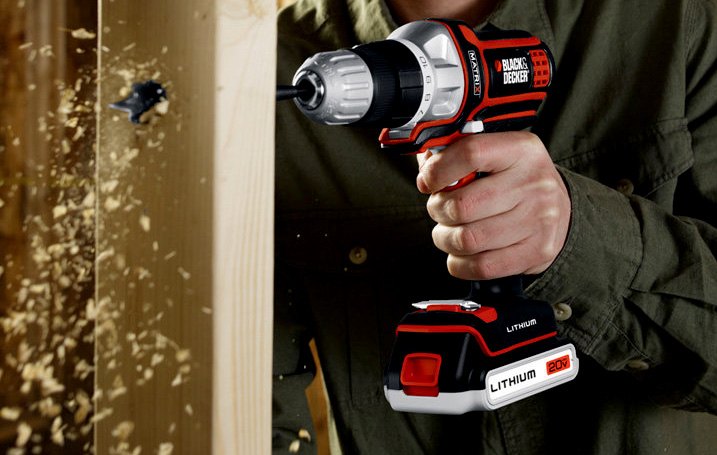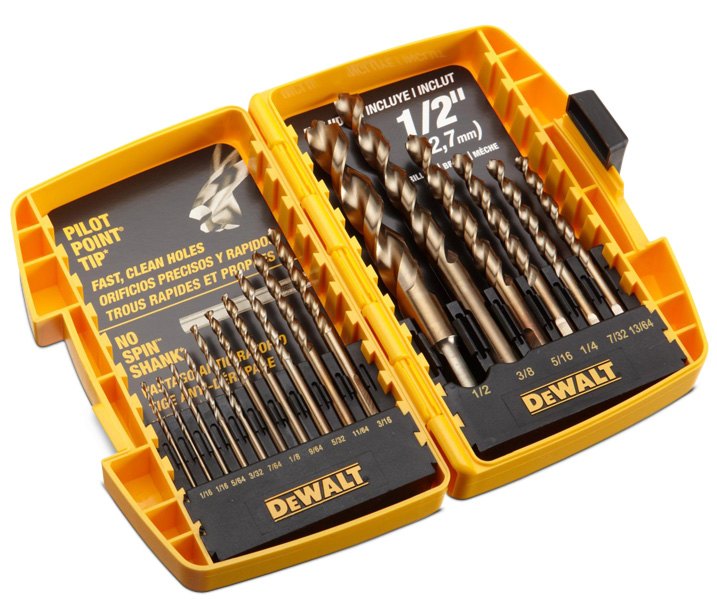
In the good old days, it was so simple: if you needed a drill, you went out and bought one. It was made of metal, it had a single speed (fast), and it spun in one direction (forward). You got a drill bit, inserted it into the chuck, and tightened it down with a chuck key. You plugged the drill's cord into the wall and drilled a hole into the material of choice. If what you were drilling was immovable (like your kitchen wall), and there wasn't an outlet nearby, you got an extension cord. Did we ever expect the tool industry to improve on this formula?
To resounding thanks of all of us, the formula HAS been improved, in multiple ways. There are almost too many choices, what with the advent of the cordless drill. We now can stare at what seems like an overwhelming number of variables in battery voltage, chuck size, speeds, and more things we don't always understand. To add to the confusion, corded (household current) drills are still on the market. In this article, we will do our best to shed some light on all the drills and drivers we have on our digital shelves, explain the differences, and provide you with the information you need to make an informed purchase decision.
For the sake of clarity, our focus in this article will be on drills and drill-drivers, tools designed primarily to use drill bits to drill holes in wood and metal, and to use screwdriver bits (like Philips and hex) to drive threaded fasteners. Powered screwdrivers, hammer-drills, right-angle drills, and other specialty tools are outside our scope today.
Cordless Drills
Most home Do-It-Yourselfers, hobbyists, and shade tree mechanics have switched over to cordless drills. Why? You cannot beat the convenience of not being tied by a power cord to a household outlet. Today's batteries are stronger than ever, last a good long time, and will quickly recharge. Cordless models let you move from inside the house, to the garage, up a ladder, then 100 feet out into the backyard, with full power (literally) at your fingertip.
Drill Types
The left side of our screen shows you additional menu choices, such as chuck type, power type, and voltage. How to choose? Here is a list of the kinds of features for you to consider, which are standard or optional on today's cordless drill drivers:

- Battery charger: Most, but not all, cordless drills include the charger. Purchasing a tool without the charger makes sense if you already have a charger from that manufacturer, and you're adding to the arsenal. Otherwise, be sure to budget for the charger.
- An extra battery: This is THE ticket for efficient use of the cordless drill. The concept is that one battery is always in the tool, and the other is in the charger. You are never without power, IF you remember to plug the charger in!
- Battery voltage: When cordless drill-drivers first hit the market in the 1980s, the batteries were 7.2 volts. Today's drill-drivers range all the way up to 20 volts. The higher the voltage, the more power you have; you will live with a heavier battery and greater initial cost for the higher voltages.
- Battery type: The two most common battery types in today's cordless drills are nickel-cadmium (NiCd) and lithium-ion (Li-ion). It is without doubt that the Li-ion batteries, although more expensive, vastly outperform their NiCd colleagues. They charge faster, keep their charge longer, and weigh less.
- Weight: Almost all of these drills are made of high-strength plastic, unlike the metal drills of yore. Plastic saves considerable weight. Batteries can be heavy, and get heavier as the voltage goes up. Don't discount the value of a "light-weight" drill. If you are working with this tool most of the day, an unnecessarily heavy drill will run you down before the battery runs down.

- VSR (Variable Speed Reversible): A given on most modern units, be sure to check that this is on the drill you buy. Variable speed is administered through simple finger pressure on the trigger. This gives you tremendous control of the torque, especially when driving screws. Reversible drills are required if you are going to be removing screws. The reversing feature can also help you remove a stuck drill bit.
- Speed: you will sometimes see a "range" of speeds; this tells you the minimum and maximum drill speed. If you see TWO ranges, then the drill has a "low range" and a "high range", the low typically used for driving, and the high for drilling. This is nice as it helps keep you in the desired range.
- Variable clutch settings: this feature is especially important if you will be using the tool more for driving fasteners than for drilling holes. An adjustable "clutch" means that the tool will stop driving (you may see the word "overrun") at a predetermined torque. When driving screws into soft material, the clutch prevents the tool from driving the screw in too deeply, which would damage the material. We've seen cases where a drill-driver without a clutch (or a clutch set too high) will actually snap the threaded fastener.
- Keyless chuck: instead of a key (how old-fashioned), a keyless chuck is simply tightened by hand. No key to use and then lose, and much faster insertion and removal of bits.
- Chuck size: typically listings will be for 1/4" 3/8", and 1/2". This refers to the maximum opening of the chuck, and determines the largest bit you can install. In general, the more powerful drills offer the larger chucks. Also check to see what size bits you have today, or consider what your drilling needs will be.

Drill-Drivers
As we stated above, the industry's first cordless drill-drivers functioned with 7.2 volt batteries. While most drills offer more power than that today, don't dismiss this voltage as a choice. The Ingersoll Rand 1/4" 7.2V Mini Cordless Drill is one of the smallest and lightest of its kind on the market, able to fit in tight spaces that larger drills cannot. We can picture this serving as a second or back-up unit to a larger drill.
Stepping up to 12V of power, the Black and Decker LDX112C offers a lot of features for the price. Keep in mind with this product that a battery charger would be purchased separately.
The 18 Volt Cordless category may offer the widest selection of drill drivers. Eighteen volts gives you 2.5 times as much power as a 7.2V unit. Consider a "kit", as a kit gives you everything you need with one click of the mouse. For example, the Makita 18V 1/2" Compact Drill Driver Kit includes two batteries, a battery charger, plus storage case. Likewise, the DeWalt 18V Cordless Compact Drill Driver has two speed ranges, a keyless chuck, 17 clutch settings, and weighs only 4.8 pounds. This kit includes 2 batteries plus charger, all packed into a kit box.
The highest powered units are using a full 20 volts. Although pricey, you still have options. The Ingersoll Rand 20V Cordless ImpacTool Kit lets you choose between 3/8" drive and 1/2" drive chucks, and between one battery or two batteries per kit.

"Corded" Drill
You can still purchase a "corded" drill, although there are far fewer choices than there are for the battery-driven types. An electric drill could be just the item for someone who uses a drill only occasionally. Advantages of the 120-volt product include consistent power, and no need to recharge or replace batteries. Look for a VSR (variable speed reversible) drill, such as this incredible bargain from Trades Pro. Kawasaki has a similar drill with the added convenience of a keyless chuck. At just a touch over 4 lbs., the DeWalt VSR drill steps up to an 8 amp motor plus a keyless chuck.
If you need additional or replacement batteries or battery chargers, we have those too! And a drill-driver is useless (unless you like fancy paperweights) without bits which do the actual work. Again, we have the internet's most outstanding selection of bits and other accessories such as chuck keys and hole saws. If you are purchasing your first power drill, welcome to the club! If you're switching over to a cordless unit, or perhaps stepping up to one with higher voltage, we guarantee that you'll wonder how you got along without it!

